This post may contain affiliate links. Exploring new sights is a participant in the Amazon Services LLC Associates Program. As an Amazon Associate, we earn from qualifying purchases linking to Amazon.com and affiliated links.
Out of the many types of RVs including Pop Up Campers, Fifth Wheels, and Motorhomes, Travel Trailers take the lead as the most commonly purchased style of RV. They are also the cheapest way to get into RVing. So, if you are on the market then this Travel Trailer Overview will help you get started in your RVing Journey!
First, what exactly is a travel trailer? A travel trailer, also known as a camper trailer, has the same amenities as a brick and mortar home, just on a smaller scale. They have sinks, bathrooms, beds, dining, and of course kitchens. Travel Trailers provide a much more comfortable and secure sleeping arrangement, compared to a tent.
All travel trailers both large and small require a tow vehicle that is adequate in size and always hooks to the bumper or tow hitch. This is what they call a “bumper pull”. Due to the fact that they require an SUV or Pick up truck to tow, this allows you to continue to use your vehicle while the Trailer sits during off-seasons or at the campground. If you are in a great area and need to run to the store or want to explore, you don’t have to completely unhook everything from the trailer just to pick up some milk or go hiking. Whereas in a motorhome (unless you tow a lightweight vehicle with your motorhome) you will have to unhook the entire motorhome to go anywhere.
Another great advantage of the tow vehicle is the safety features including crash protection, blind spot detection, and more. Tow vehicles also allow you to safely travel with children and their car seats, which is not usually available with motorhomes.
When did the Travel trailer first make an appearance?
Travel trailer first appeared in the 1920s. Those who enjoyed them were often called “tin-can tourists”. Throughout the decades, travel trailers became a livable option for many people, and this sparked the nickname “house trailers” by the 30s and 40s.
However, it wasn’t until the 1970s that the demand for a full hard-shell travel trailer rose to new heights. This was when the modern-day fiberglass body made its first appearance. The travel trailer industry boomed, as more North American and Canadian families enjoyed taking road trips for their vacations.
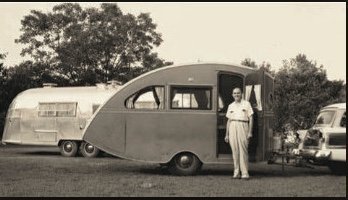
How has travel trailers changed over the years?
The Travel Trailer industry has continued to grow. Manufacturers began to build a smaller class, called Light Weight travel trailers, that are under 3,000 lbs. and average 11 to 18 feet in length. There are also mid-size trailers usually about 18 to 25 feet in length that weigh around 5,000 lbs or more. The mid-size and lightweight trailers are easily towed with a 1/2 ton pick up truck or SUV. Both trailers have many of the same amenities as the larger trailers but tend to sleep fewer people.
Larger travel trailers generally ranging from 25-40 feet are designed for seasonal and even full-time users in mind. The weight of the larger travel trailers can range from 9,000 lbs. to 12,000 lbs. These trailers usually need a heavier tow vehicle that is built to pull the required amount of weight such as the 3/4 ton or even a 1-ton pickup truck.
The larger style travel trailers also boast more variety of options, including multiple slide outs to open the space up. They fit more people for sleeping by including pull out couches and bunkhouses.
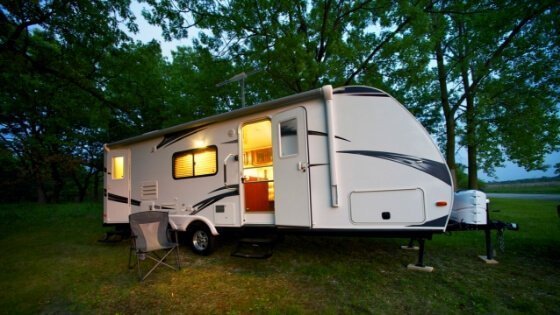
Who are the top manufacturers?
There are many manufacturers today that specialize in travel trailers, one of the most popular is the Airstream.
Other manufacturers include;
- Coachman
- Forest River Inc.
- Palomino RV
- Dutchman
- Heartland
- Jayco
- Winnebago Industries
- Keystone
- Grand Design
- And more…
Each Manufacturer has its own styles, amenities to choose from, quality of products, and much more. For us, the floorplan was the most important, then we began our search for Manufacturers that had the plan or similar plans and compared the quality.
What are the different styles and amenities to choose from?
Here are just a few of the options for style and amenities you can choose from.
- 1 to 3 Slides to open the spaces.
- Outdoor Kitchen and Entertainment Areas
- Bunkhouse for extra sleeping space for families
- Stainless Steel Appliances
- Solar Ready Equipment
- Electric Fireplace
- Kitchen Island
- Washer & Dryer Prep
- Dining booths or Table with Chairs
- Theater Seating
- Variety of Colors and Styles/Floorplans to Choose
As you can see there are many choices to make when choosing the right Travel Trailer. When we decided on what amenities we wanted, we tried to make sure it was amenities that would make us happy and enjoy the full-time RV lifestyle.
For you, the amenities can vary depending on what you are planning to use your Travel Trailer for. If it’s just weekend camping trips, the smaller lightweight trailers are a great option! However, if you’re seasonal, or full time like us, there are larger options that work great for singles, couples, or families!
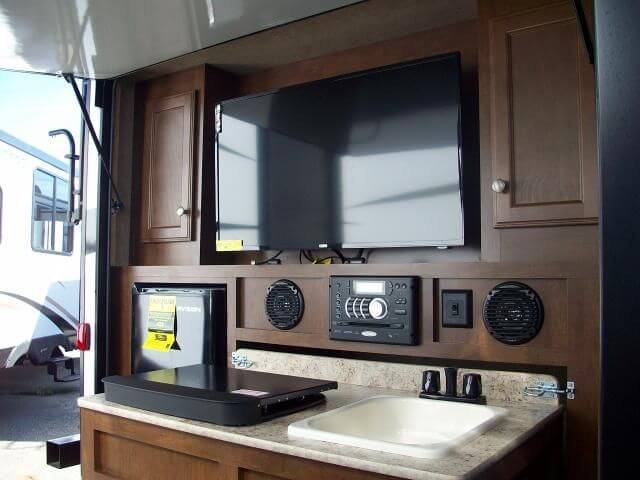
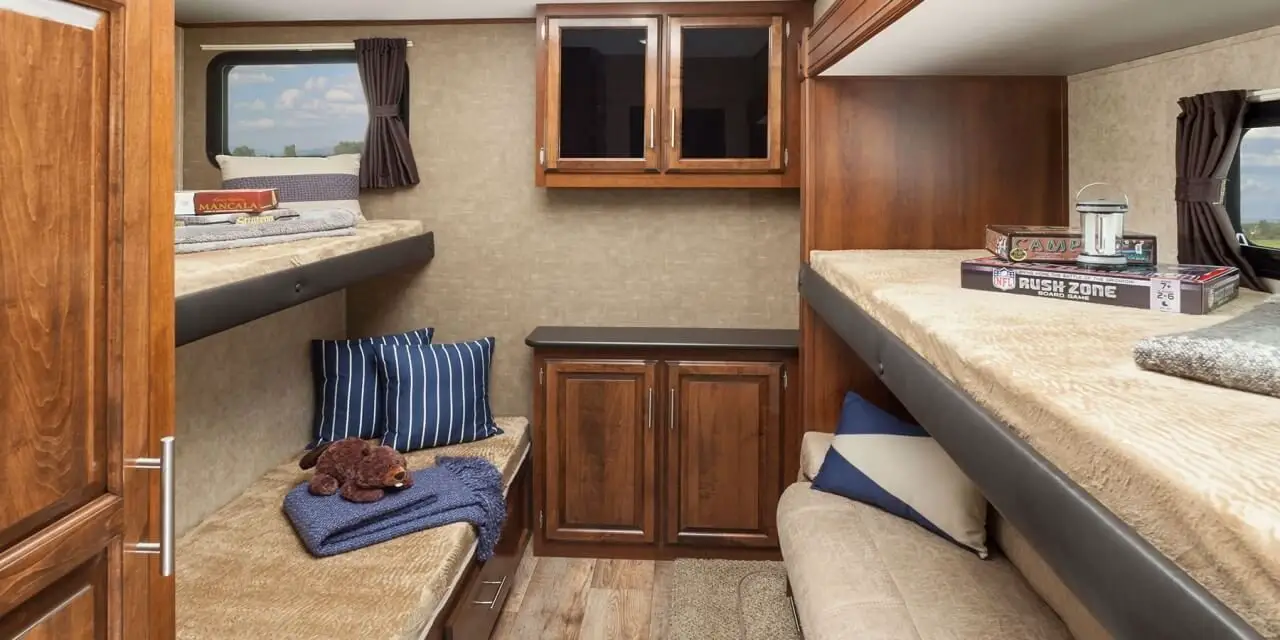
What are the Pros and cons of a Travel Trailer?
Pros
-
- Lightweight options
- A large variety of styles, manufacturers, price, and sizes
- Lower price compared to fifth wheels and motorhomes
- Better Insulation than a popup camper or tent
- Easy setups
Cons
-
- Needs a tow vehicle adequate to the size of the trailer.
- Difficult to park and back up. Takes practice.
- Some large trailers can be too big for campgrounds
- Depreciate in value
Quick Travel Trailers Overview
- Travel trailers range from 8 ft to 40 ft.
- Weight averages from less than 3,000lbs up to 10,000lbs.
- They have the ability to sleep either 2 to 10 people.
- Average price starting under $10K for your small lightweights and can skyrocket to $200K
- Great to take camping and will keep you more secure than a tent.
- Larger Travel Trailers can even be used for seasonal or full-time living.
What We Chose
Our journey to finding our Travel Trailer took almost a year of research and planning. We shopped and compared an endless amount of floorplans and amenities before we made our final decision. We also had to make sure that our Tow Vehicle was the adequate size to pull whichever trailer we chose.
After all the research we decided on the Palomino Puma 31 RLQS. Our travel trailer is about 9,000 lbs, 32ft long, and we chose the 3/4 ton Dodge Ram 2500 Diesel with a Max tow of 10,750 lbs.
For us, the floor plan was the most important. We wanted the couches/living area to be a true living space with the T.V. in front of the couches. We also loved how the three slides opened up the area for a more comfortable living.
The final and most important feature we needed was a washer and dryer prep. Surprisingly, there are not many options for Washer and Dryer preps in Travel Trailers, so with that being a number one must have, it cut our options quickly to the Palomino or Jayco. We chose Palomino, which is owned by Forest River Inc., but handle their own manufacturing and have a great price point.
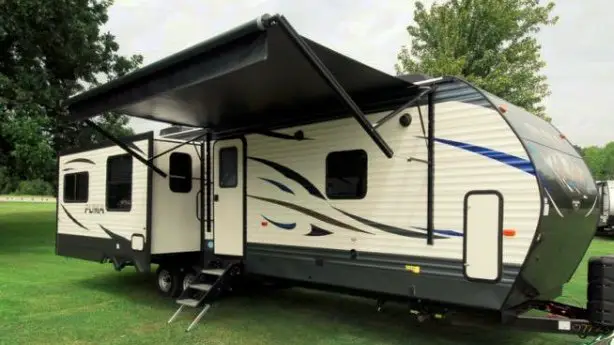
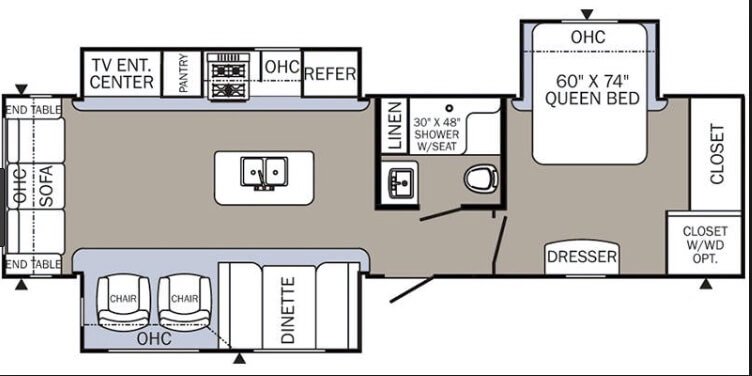
Travel trailers are great options for anyone looking to live a life of adventure while also maintaining the comforts of modern technology. As technology increases so does the RV industry.
We chose to purchase a travel trailer due to floor plan and price. They are usually cheaper than fifth wheels and many have the same amenities.
I hope this travel trailers overview helped you on your journey of searching for the perfect RV.
Whatever you fancy, there is bound to be a travel trailer out there that has it all for you.
Do you have a Travel Trailer? If so what is something you enjoy about it? Comment below! Also, don’t forget to share so others can learn more about Travel Trailers!
Pin To Save For Later
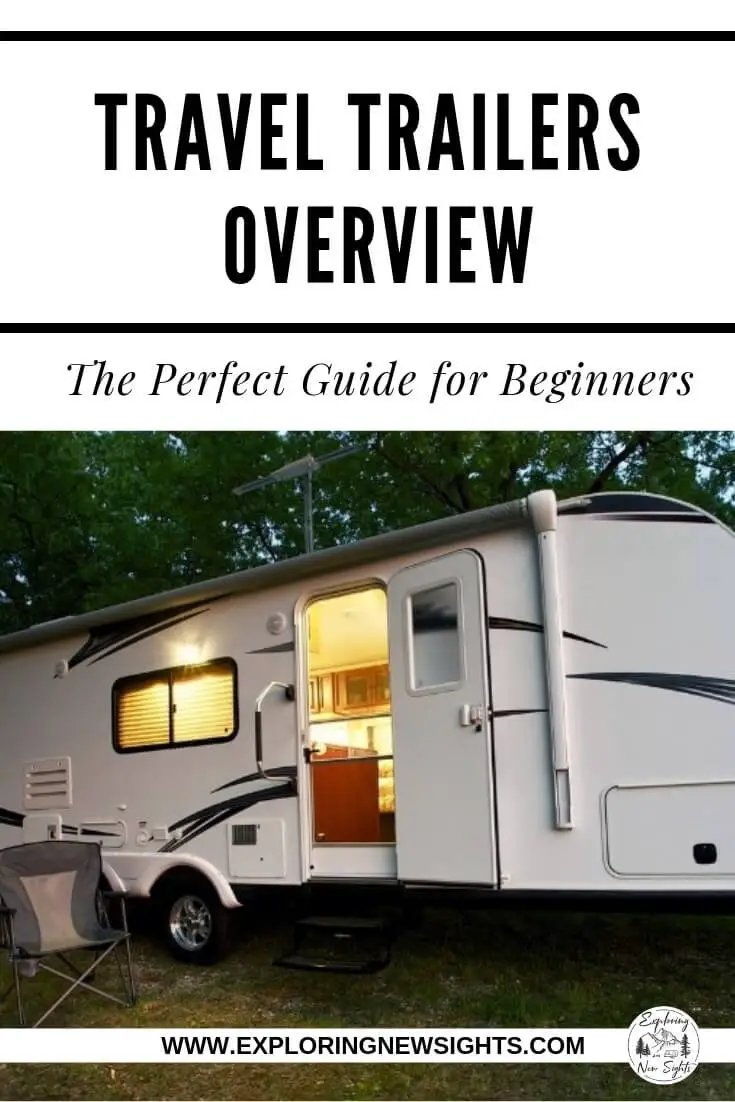
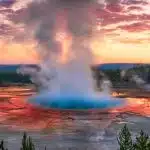








Thank you for the article debtor how you can start traveling with a trailer. My husband would love to travel the county in one. We will look into buying a trailer and what will be ned to maintain it.
This is some seriously amazing information you have here. Wow!! I can’t believe how far these have come over the years. I don’t think we could ever live in one, but travel in one? Maybe some day…
Good advice about taking your time to check everything out. You are a great advisor. Thanks for advising these simple Travel Trailer Overview tips..
Thank you so much!
Another bonus to some travel trailers is that they are not as tall and may fit in your garage. Also, a travel trailer keeps your pickup box open for you to bring “toys” (think 4 wheeler). Great article!!
Great tips! I might just have to have them to this article! Thank you, Nicki!
Seriously great points on choosing the right travel trailer, I really like your floorplan and having a laundry area would be a key factor for us too! Thanks so much for sharing 🙂
Thank you for reading! 🙂
Great tips for beginners in the RV world. Some day we’d like to take an RV road trip to see if we’d like it.
I hope you do someday! Thanks, Susan!
I learn so much from your posts! This sounds like a great option.
Thanks, Cindy!
So many choices! Looking forward to planning a RV vacation!
Hope you enjoy it! 🙂
This makes me want to get one! I love road trips!
You should! They are great!
We have a toy hauler. It was not my choice. I prefer tent camping. But I would have been fine with a pop-up or those little itty bitty campers.
I enjoy tent camping too! Thanks for reading!
What a lot of great information…I had no idea there were so many choices. With empty nesting on our horizon this might be useful sooner rather than later!
What a great ‘101’ Thank you!
Those travel trailers look amazing! I would totally live there!
I grew up in an Airstream family. Like they owned plots at Airstream parks family. lol I want an Airstream and my kids think I am crazy because there are no sliders. So nostalgic for me though.
We looked at a lot of travel trailers but we ended up going with a used fifth wheel. It had everything we wanted and we are able to renovate to make it our own!
I really don’t think that I realized there were so many options available! This is great information to help narrow it all down.
Wow, I had not even realized that there were different kinds of travel homes! Very cool informative article. I am hoping to travel like you do someday 🙂
It’s amazing how far these things have come!! I think I could live in one..sort of like a tiny house!!
Thanks for all the beginner tips! So helpful.
Great point about the versatility of the travel trailer vs an all in one motorhome. It’s much more mobile when you can just detach your truck or SUV and go exploring! Would love to try this one day!
No travel trailer for me, but I would sure love one! I was just looking into renting one, and prices start at almost $200 a day for a motorhome. It sure looks fun to tour the country though. Glad you get such an amazing opportunity!
This is so cool! I wish I could convince my hubby to get one for our family. I love to travel and mostly I love road trips. This would be perfect! Thanks for sharing
You all definitely should someday! Sounds like you will enjoy it!